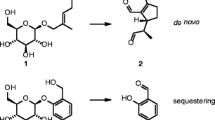Abstract
The acetylenic acid,Z-dihydromatricaria acid (DHMA), previously isolated from the defensive secretion ofChauliognathus lecontei, and now shown to occur also inC. pennsylvanicus, is a potent feeding deterrent to jumping spiders (Phidippus spp.). A simple bioassay withPhidippus is described, which is generally applicable to studies dealing with the isolation and evaluation of feeding deterrency of natural products from insects. By use of this assay,Phidippus were shown to be sensitive to as little as 1 μg DHMA, an amount equivalent to less than 2% of the DHMA content ofC. pennsylvanicus.
Similar content being viewed by others
References
Eisner, T. 1970. Chemical defense against predation in arthropods, pp. 157–217,in E. Sondheimer and J.B. Simeone (eds.) Chemical Ecology. Academic Press, New York.
Eisner, T., Kluge, A.F., Carrel, J.C. andMeinwald, J. 1971. Defense of a phalangid: Liquid repellent administered by leg dabbing.Science 173:650–652.
Eisner, T., Aneshansley, D., Eisner, M., Rutowski, R., Chong, B., andMeinwald, J. 1974. Chemical defense and sound production in Australian tenebrionid beetles (Adelium spp.)Psyche 81:189–208.
Eisner, T., Jones, T.H., Hicks, K., Silberglied, R.E., andMeinwald, J. 1977. Quinones and phenols in the defensive secretions of neotropical opilionids,J. Chem. Ecol. 3:321–329.
Gibbs, R.D. 1974. Chemotaxonomy of Flowering Plants, Vol. 1, p. 89. McGill-Queen's University Press, Montreal.
Meinwald, J., Meinwald, Y.C., Chalmers, A.M., andEisner, T. 1968. Dihydromatricaria acid: Acetylenic acid secreted by soldier beetle.Science 160:890–892.
Remold, H. 1962. Uber die biologische Bedeutung der Duftdrüsen bei Landwanzen (Geocorisae).Z. Vergl. Physiol. 45:636–694.
Sørensen, N.A. 1963. Chemical taxonomy of acetylenic compounds, pp. 219–252,in T. Swain (ed.). Chemical Plant Taxonomy. Academic Press, New York.
Tschinkel, W.R. 1975. A comparative study of the chemical defensive system of tenebrionid beetles. Defensive behavior and ancillary features.Ann. Entomol. Soc. Am. 68:439–453.
Author information
Authors and Affiliations
Additional information
Paper no. 67 of the seriesDefense Mechanisms of Arthropods. Paper no. 66 is: Goetz, M.A., Meinwald, J., and Eisner, T.,Experientia. In press.
Rights and permissions
About this article
Cite this article
Eisner, T., Hill, D., Goetz, M. et al. Antifeedant action ofZ-dihydromatricaria acid from soldier beetles (Chauliognathus spp.). J Chem Ecol 7, 1149–1158 (1981). https://doi.org/10.1007/BF00987634
Received:
Revised:
Issue Date:
DOI: https://doi.org/10.1007/BF00987634




